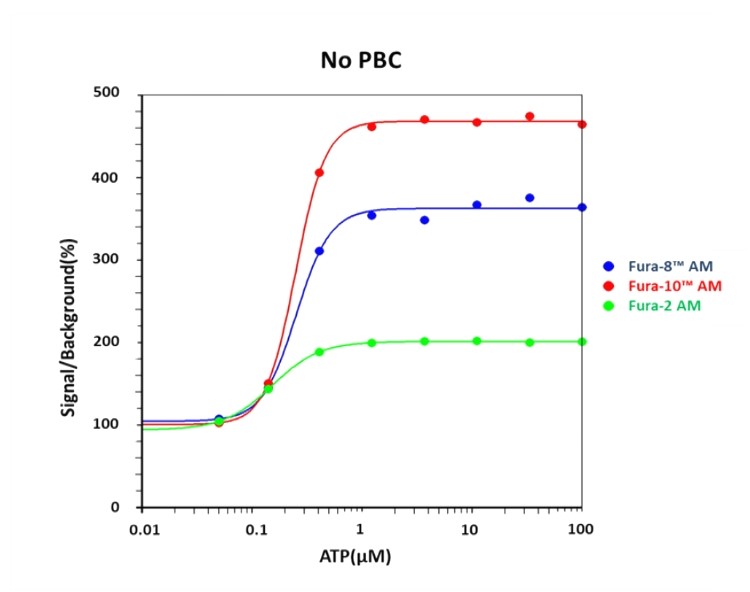
Search our suppliers catalog
AAT Bioquest
AAT Bioquest

News about AAT Bioquest
Cell Viability Indicators: passive intracellular diffusion, low cytotoxicity, superior cell retention, and strong fluorescence intensity in the physiological pH range.
Compared with other live cell-labeling reagents (such as BCECF-AM), calceins are a more favored fluorescent probe for staining viable cells due to reliability and flexibility. In addition, calceins do not affect lymphocyte chemotaxis or general cell proliferation.
To address the single color limitation of calcein AM, AAT Bioquest has developed calcein derivatives in a broad range of color options, from violet to deep red dyes for multicolor labeling and functional analysis of live cells. Their selection table provides a summary of the entire spectrum of options, including common properties and applications.
Click To Explore Calcein Viability Dyes
Ratiometric Calcium Indicators
Ratiometric Calcium Indicators: Performance & Selection Criteria
Ratiometric calcium indicators are designed to monitor calcium mobilization with greater accuracy and sensitivity. When bound to free Ca2+, the peak wavelength of either the excitation curve or emission curve of the ratiometric indicator will undergo a shift. This allows for very precise measurements of Ca2+ concentrations by correcting for uneven dye loading, dye leakage, and varying cell thicknesses.
For any experiment, the selection criteria for a ratiometric calcium indicator will depend on the instrument platform, the expected Ca2+ concentrations, and others. In general, it is useful to consider:
- Calcium sensitivity and response
- Filter set compatibility
- Signal/background ratio
- Cell retention (can vary by cell type)
Among ratiometric calcium indicators, Fura-2 and Indo-1 are the most widely used, although both have drawbacks in the form of only moderate signal/background ratio and poor cell retention. Fura-8™ demonstrates significant improvement in the signal/background ratio, and Fura-10™ outperforms both options and remains within cells significantly longer.
 |
Image: ATP-stimulated calcium response of endogenous P2Y receptor in CHO-K1 cells measured with Fura-2 AM, Fura-8™ AM and Fura-10™ AM in the absence of Probenecid: CHO-K1 cells were seeded overnight, then Fura-2 AM or Fura-8™ AM or Fura-10™ AM without probenecid was added into the cells, and ATP was added to achieve the final indicated concentrations. |
Check the product brochure for more information: Calcium Detection Probes & Assay Kits
Info AAT Bioquest
Advancing Assay & Test Technologies.
AAT Bioquest, Inc. develops, manufactures and markets bioanalytical research reagents and kits to scientists engaged in life sciences research, diagnostic R&D and drug discovery. They specialize in the area of photometric detections including absorption (color), fluorescence and luminescence technologies.
AAT Bioquest constantly introduces new products, and offers a rapidly expanding list of products that are grouped into several product lines.
1) Reactive fluorescent and luminescent probes, biotins and tag enzymes are used for labeling small drug molecules and biopolymers, e.g, proteins, nucleic acids and carbohydrates;
2) Fluorescent and luminescent probes for detecting proteins, nucleic acids and live cells;
3) Novel fluorescent and luminescent probes for detecting various enzymes, in particular, hydrolytic and redox enzymes;
4) Reagents for signal transduction research;
5) Physiological and neurological probes, e.g., calcium indicators and membrane potential probes.
AAT Bioquest, Inc. develops, manufactures and markets bioanalytical research reagents and kits to scientists engaged in life sciences research, diagnostic R&D and drug discovery. They specialize in the area of photometric detections including absorption (color), fluorescence and luminescence technologies.
AAT Bioquest constantly introduces new products, and offers a rapidly expanding list of products that are grouped into several product lines.
1) Reactive fluorescent and luminescent probes, biotins and tag enzymes are used for labeling small drug molecules and biopolymers, e.g, proteins, nucleic acids and carbohydrates;
2) Fluorescent and luminescent probes for detecting proteins, nucleic acids and live cells;
3) Novel fluorescent and luminescent probes for detecting various enzymes, in particular, hydrolytic and redox enzymes;
4) Reagents for signal transduction research;
5) Physiological and neurological probes, e.g., calcium indicators and membrane potential probes.
Currently there are no products of the brand AAT Bioquest in our catalog.



